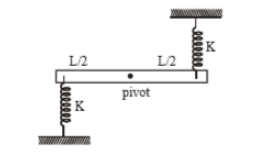If the displacement \(x\) and the velocity \(v\) of a particle executing simple harmonic motion are related through the expression \(4v^2= 25-x^2,\) then its time period will be:
1.
\(\pi \)
2.
\(2 \pi \)
3.
\(4 \pi \)
4.
\(6 \pi\)
Two simple pendulums have time periods T and . They start vibrating at the same instant from the mean position in the same phase. The phase difference between them when bigger pendulum completes one oscillation will be:
1.
2.
3.
4.
A simple pendulum is oscillating without damping. When the displacement of the bob is less than maximum, its acceleration vector \(\vec a\) is correctly shown in:
| 1. |  |
2. |  |
| 3. |  |
4. |  |
The uniform stick of mass m length \(\text L\) is pivoted at the centre. In the equilibrium position shown in the figure, the identical light springs have their natural length. If the stick is turned through a small angle , it executes SHM. The frequency of the motion is:


1. \(\frac{1}{2 \pi} \sqrt{\frac{6 K}{m}} \)
2. \(\frac{1}{2 \pi} \sqrt{\frac{3 K}{2 m}} \)
3. \(\frac{1}{2 \pi} \sqrt{\frac{3 K}{m}} \)
4. None of these
A particle undergoes SHM with a time period of 2 seconds. In how much time will it travel from its mean position to a displacement equal to half of its amplitude?
(1)
(2)
(3)
(4)
A second's pendulum is mounted in a rocket. Its period of oscillation decreases when the rocket:
(1) Comes down with uniform acceleration
(2) Moves around the earth in a geostationary orbit
(3) Moves up with a uniform velocity
(4) Moves up with the uniform acceleration
There is a simple pendulum hanging from the ceiling of a lift. When the lift is stand still, the time period of the pendulum is T. If the resultant acceleration becomes g/4, then the new time period of the pendulum is
(1) 0.8 T
(2) 0.25 T
(3) 2 T
(4) 4 T
A block \(P\) of mass \(m\) is placed on a frictionless horizontal surface. Another block \(Q\) of same mass is kept on \(P\) and connected to the wall with the help of a spring of spring constant \(k\) as shown in the figure. \(\mu_s\) is the coefficient of friction between \(P\) and \(Q\). The blocks move together performing SHM of amplitude \(A\). The maximum value of the friction force between \(P\) and \(Q\) will be:

1. \(kA\)
2. \(\frac{kA}{2}\)
3. zero
4. \(\mu_s mg\)
| 1. | \(2A,A\) | 2. | \(4A,0\) |
| 3. | \(A,A\) | 4. | \(0,2A\) |
| 1. | the motion is oscillatory but not SHM. |
| 2. | the motion is SHM with an amplitude \(a\sqrt{2}\). |
| 3. | the motion is SHM with an amplitude \(\sqrt{2}\). |
| 4. | the motion is SHM with an amplitude \(a\). |






